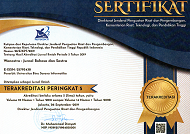Ekonomi Bayangan Dalam Novel Pulang Karya Tere Liye Berdasarkan Teori Konspirasi
Abstract
Full Text:
PDFReferences
Barkun, Michael. (2003). A Culture of Conspiracy: Apolyptic Vissions in Contemporary America. Berkeley: University of California Press.
Byford, Jovan. (2011). Conspiracy Theory: A Crictical Introduction. New York: Palgrave MacMillan.
Caody, David. (2006). An Introduction to the Philosophical Debat about Conspiracy Theories. Coady, David. “Conspirasi Theories: the Philosophical Debate”. Burlington: Ashgate
Scheider, Frierich. Buehn, Andreas; dan Montenegro Claudio E. (2011). Shadow Economies all Over the World: New Estimates for 162 Countries from 1997-2007. Schneider, Friedrich. Handbook on the Shadwo Economy. Cheltenham: Edward Elgar.
Schneider, Friedrich dan Enste, Dominick. (2002). Hiding in the Shadwos: The Growth of the Underground Economy. Washington: International Monetary Fund.
______________ (2013). The Shadow Economy: An International Survey. Cambridge: Cambridge University Press.
Liye, Tere. (2015). Pulang. Jakarta: Republika.
Williams, Collin C. (2014). Confronting the Shadow Economy: Evaluating Tax Compliance and Behaviour Policies. Cheltenham: Edward Elgar.
Wisnicki, Andrian S. (1999). Conspiracy, Revolution, and Terorrism from Victorian Fiction to the Modern Novel. London: Routledge.
Walker, Jesse. (2013). The United States of Paranoia: A Conspiracy Theory. New York: Harper.
DOI: https://doi.org/10.31294/w.v7i2.1734
Copyright (c) 2017 Andika Hendra Mustaqim

This work is licensed under a Creative Commons Attribution-ShareAlike 4.0 International License.
Index by:
Published by Department of Research and Community Service (LPPM) Universitas Bina Sarana Informatika by supported Relawan Jurnal Indonesia
Jl. Kramat Raya No.98, Kwitang, Kec. Senen, Jakarta Pusat, DKI Jakarta 10450

This work is licensed under a Creative Commons Attribution-ShareAlike 4.0 International License






